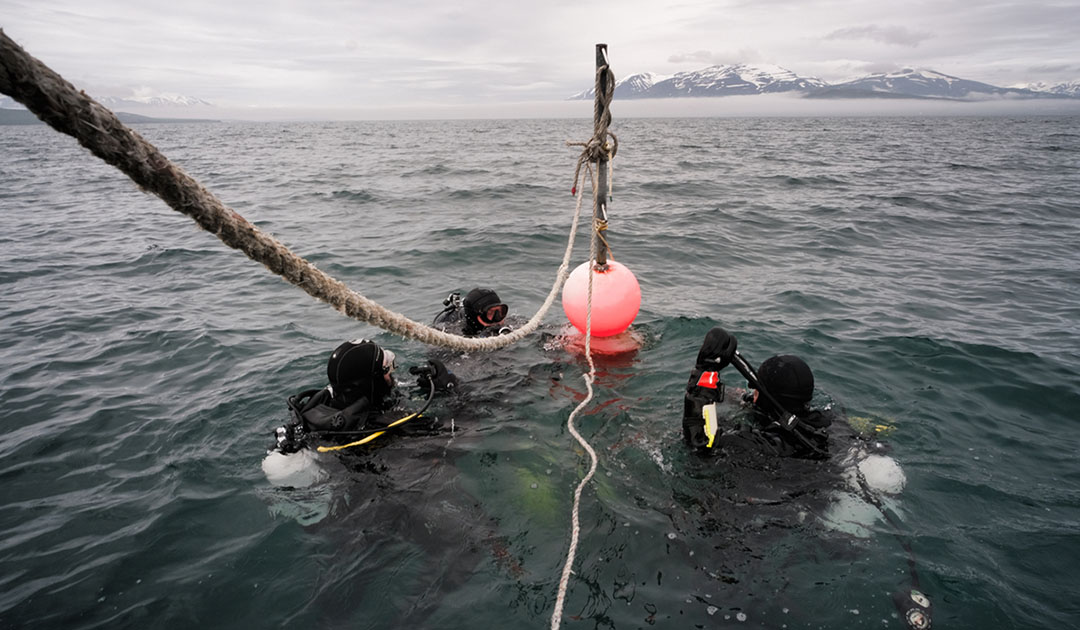
Thinking of Iceland we imagine volcanoes, rain, open spaces where wind and vapours exhaled from a restless land makes it “like being on the Moon”. But, looking offshore, as some scientists suggest, Iceland could offer another experience: “like diving in an ancient Martian ocean”. This analogy with Mars, in Iceland’s underwater fjords, is now attracting geochemists, microbiologists, astrobiologists, and NASA.
It’s not surprising to learn that for space and life scientists Iceland is a training ground for developing devices to be sent to other planets. Yet, when one thinks of the Icelandic coasts, one imagines the many whale watching tours offered in the short sub-arctic summer. It’s however hard to think that the seabed might hide one of the Earth’s greatest geological curiosities, which could help us to understand how our neighbour planet evolved. Indeed, north of the island there is a geological rarity that makes Iceland the best analogue of the ancient surface of Mars, when the red planet still possessed an ocean approximately 4 billion years ago. And could have, possibly, hosted life.

In a quest to understand if Mars was once a habitable planet, geochemist Roy Price and student Arlaine Sanchez from Stony Brook University in New York, together with microbiologist Donato Giovannelli from the Federico II University in Naples, scuba dived in the dark, murky, plankton-rich waters off Akureyri. Around them they could observe the rocky shores of the Akureyri fjord in the north of the large island straddling the mid-Atlantic ridge.
“This summer’s expedition is part of a NASA Habitable Worlds program funded project,” Price says as he prepares himself by wearing a dry suit and several insulating layers, as the water in which he and Giovannelli will dive has a temperature of around 6-7°C. On the Zodiac, while crossing the gulf, Price says: “Here in Eyjafjörður is what we consider the best terrestrial analogue of the Eridania Basin on Mars, an ancient basin that has now disappeared. It is the ideal place to test our hypotheses about the habitability of early Mars. We want to answer the question: Is it possible that in the Martian ocean 3-4 billion years ago there were conditions that could have supported life?”

In the centre of the fjord, invisible from the surface, lies the natural wonder where an answer could be found: the geothermal chimneys of the Strytan Hydrothermal Field. While black smoker sulfide-rich vents and chimneys have been found in the depths of the earth’s oceans, near ocean ridges, they are found at depths that can only be reached by remote-controlled means and at great expense. This particular hydrothermal field is, on the other hand, accessible by diving. In addition, the vent chimneys are unique; they are composed of a rare mineral called saponite, which is a combination of magnesium and silica. To date, no other chimneys like Strytan have been found on Earth.
“They are chimneys of a magnesium silicate mineral called Saponite, which forms where a hot, mineral-rich spring of water emerges from the seabed,” Price explains. “The towers are up to 55 metres high from the sea bottom, the spring has a temperature of about 70°C and has a very high pH, about 10, which makes the fluids very alkaline. The environment they generate is amazing and closely resembles some concretions discovered on Mars. Here I can combine my passion for scuba diving and the study of geothermal activity”, he says.

Price explains that in the search for past or present life forms on other planets, it is crucial to understand the relationship between geochemistry, the chemical properties of rocks, and biology. “Studying terrestrial analogues of other planets can help us be more precise in how we define the habitability of other celestial bodies,” he says.
Just before diving into those Icelandic depths the two scientists-divers listen attentively to the directions and recommendations of Erlendur Bogason, a professional diver at the Strytan diving shop, not far from Akureyri. It was he who rediscovered the towers, which had already been mentioned by fishermen and other locals, searched for by several international expeditions but never found until he spotted them in 1997 and brought them to light. Since then, the chimneys have been protected, although they can be visited, and Bogason is their guardian and, if necessary, guide.

Giovannelli says: “From what we know, this place is truly unique, there are the reactions between rock and water that might have existed in the Eridania basin 3-4 billion years ago. We will collect water samples, samples of these rock concretions, and we will also see what forms of life may have colonised this extreme, hot, alkaline, submerged environment.”
The samples collected in 45 minutes of diving in these waters, whose surface is buffeted by the wind and flown over by terns and seagulls, are collected and catalogued by Sanchez in what is a bizarre improvised laboratory above the main room of Bogason’s dive shop. Surrounding her are an dozens of objects that Bogason collected from the bottom of the fjord: from a fragment of an ancient anchor, all rusted, to cameras from the 1960s, lost by some seasick tourist during a whale-watching hunt.
Giovannelli says: “We expect to find extremophile microorganisms, that is, organisms that are adapted to extreme environments on Earth and live in chemically, thermally very active places”. If such Martian-like environments can be found on Earth, the perpetually evolving geology of Iceland is the place to be.
Jacopo Pasotti, PolarJournal
Beitragsbild: Daniel Agust





